Mary Anne Yarde's Blog: The Coffee Pot Book Club , page 123
September 12, 2019
#HistoricalFiction author, Rebecca Rosenberg, is sharing an excerpt of her fabulous book — The Secret Life of Mrs. London #Giveaway @RebeccasNovels @hfvbt
Historical Fiction Virtual Blog Tours Presents…
The Secret Life of Mrs. LondonBy Rebecca Rosenberg

San Francisco, 1915. As America teeters on the brink of world war, Charmian and her husband, famed novelist Jack London, wrestle with genius and desire, politics and marital competitiveness. Charmian longs to be viewed as an equal partner who put her own career on hold to support her husband, but Jack doesn’t see it that way…until Charmian is pulled from the audience during a magic show by escape artist Harry Houdini, a man enmeshed in his own complicated marriage. Suddenly, charmed by the attention Houdini pays her and entranced by his sexual magnetism, Charmian’s eyes open to a world of possibilities that could be her escape.
As Charmian grapples with her urge to explore the forbidden, Jack’s increasingly reckless behavior threatens her dedication. Now torn between two of history’s most mysterious and charismatic figures, she must find the courage to forge her own path, even as she fears the loss of everything she holds dear.
Praise for The Secret Life of Mrs. London
“An impressively original and exceptionally well-crafted novel by an author who is a master of character- and narrative-driven storytelling, Rebecca Rosenberg’s The Secret Life of Mrs. London is an inherently riveting and thoroughly reader-engaging story from beginning to end and feature[es] many an unexpected plot twist and turn.”Midwest Book Review
“Interesting, and based on the actual lives of the participants…Learning more about Jack London was enjoyable, as well as seeing early feminist examples.”Historical Novel Society
“…Rosenberg paints an immensely intriguing portrait of a marriage and tells it in an accomplished lyrical prose that captures each moment with poetic intensity.”Prairies Book Review
ExcerptBeauty Ranch, Glen Ellen, California September 1915For her I accomplished Odysseys, scaled mountains, crossed deserts; for her I led the hunt and was forward in battle; and for her and to her I sang my songs of the things I had done.All ecstasies of life and rhapsodies of delight have been mine because of her.
And here, at the end, I can say that I have known no sweeter, deeper madness of being than to drown in the fragrant glory and forgetfulness of her hair.—Jack London, The Star RoverNothing breathes vigor into a marriage like a boxing match. And it helps to have a stupefied audience to witness the fight. If I can get Jack boxing this morning, with his drinking buddies cheering him on, he’ll be revved up for a good writing session followed by a “grand lolly” that will linger in our loins for days.
So I pull on muslin bloomers and leather boxing boots from my wardrobe, twist my hair into a topknot, daub on lavender oil for luck. Our fox terrier raises his head from my bed, ears perked. I stroke his chest and lift him down, his little heart beating in my palm. “Come on, Possum, he can’t say no to you.”
Slinging boy-sized boxing gloves over my neck, I cross the hallway to Jack’s own sleeping porch, where he sleeps it off after our houseguests plied him with martinis at the Glen Ellen saloon until the wee hours. Possum romps at my heels. Jack still reeks of gin, and his snoring drowns out the jeering blue jays.
“Rise and shine.” I whisk off the plaid blanket, exposing fine muscled legs in red flannel shorts.
Jack’s not moving. So I lift Possum up and let him lick Jack’s face. “Time for our match.”
“Charmian, no. It can’t be morning.” He pulls a feather pillow over his head, and Possum nuzzles underneath.
“Oh, but it is.” I throw the pillow to the floor, and Possum laps at his cheeks. “And a deal is a deal.”
Jack groans and lifts up onto one elbow, holding the dog off with his other hand. “I can’t do this after last night.”
“You can. I know you can.” I take Possum in my arms.
Jack’s valet, Nakata, enters with a cup of coffee balanced on his upturned palm, dressed as usual in a haori jacket and skirted trousers. “Kishi kaisei, Mr. Jack.”
Jack sits up and takes the coffee. “My head’s too fuzzy for Japanese this morning.”
Nakata smiles with teeth straight as piano keys. “Wake from death and return to life.”
Jack grimaces. “That supposed to make me feel better?” Nakata bows and leaves, Possum following him for breakfast. The Socialists criticize Jack for employing servants, but Nakata is essential to his well-being. He starts Jack’s day with platitudes and strong coffee, grants his wildest wishes, manages our household staff so we can focus on writing, and, in the evening, prepares Jack’s cot with philosophy books and farming journals, small and large writing pads, sharpened pencils, and a thermos of martinis (equal splashes of vermouth and olive juice). Together, Nakata and I handle Jack’s needs, and I pray he will never leave us.
I lace on Jack’s boxing boots while he slurps his coffee, his ankles swollen. Drinking always kicks up his gout.
“I was kidding about the boxing,” he says. “A joke for the Crowd . . .” His nickname for the Bohemian-Socialist-literary folks who worship at his feet. Come to think of it, that’s exactly where I happen to be at the moment.
“Oh no. You’re not getting away with it this time.” I knot his laces tighter. “‘Bring me the boxing gloves if I’m not up by eight,’ you said. ‘Best thing in the world for a hangover,’ you said. ‘We’ll do the drop-and-grind drill,’ you said.”
Jack smirks. “I love it when you talk dirty.”
“Come on, champ. Let’s give it a go. Our audience awaits.” I hoist his arm over my shoulders, staggering under the weight he’s gained of late.
He limps to the back door.
Nakata and some of the staff have gathered to watch on the back stoop between our separate sleeping porches, Jack’s remedy for my chronic insomnia and his late hours.
In an apron and calico dress, Jack’s sister, Eliza, washes the windowpanes, doughy underarm flesh swinging with each swipe of her dish towel. “Boxing is no good for Jack.” She clucks her tongue at me. “Just brings out the poison in his system all over again.”
“Better out than in,” I answer.
Lawrence Godfrey-Smith, the Australian concert pianist turned eucalyptus broker, and George Sterling, poet king of the Bohemians, follow us out to the porch with coffee mugs.
“What’s all the ballyhoo?” Lawrence nudges me in the overfamiliar way he’s adopted since that time on the beach in Australia . . .
I step down to the garden. “Don’t you remember Jack’s promise when you stumbled in last night? He wanted to box this morning to get his blood flowing for writing.”
“Who’s he going to wallop?”
I thrust up my gloved hand. “Me, of course.”
Lawrence turns to Sterling. “Do all American couples fight?”
“Of course,” Sterling says, stroking his goatee. “They just don’t usually wear gloves.”
It’s nine o’clock already, and the sun just cleared the top of the redwoods, illuminating the garden like an arena. Our boots crush the creeping thyme, melding with the herbaceous smell of ripening chardonnay grapes.
Jack bounces forward on his left foot, then weaves back, shifting his weight to the right, then back again. Red shorts hug his waist and skim his well-built thighs. He looks fitter than he is, from a past regimen of boxing, swimming, horseback riding. It’s not fair how men look better than us as they age. Not fair at all.
“Come on, pretty boy.” I hold my fists up in front of my face.
“Let’s see what you’re made of.”
“The legs of a Roman goddess.” Sterling whistles.
“Mind your p’s and q’s, Greek,” Jack says. “Those are my wife’s gams you’re looking at.” He throws the first punch, which lands square to my glove.
“I’m talking about yourlegs, Wolf.” Sterling combs long fingernails through his goatee, making my skin crawl. The disheveled poet could use a comb and nail scissors . . . and a bath, come to think of it.
Jack camps a pose and spins his white satin boxing sash around like Jack Johnson at the world championship.
After I take a playful poke at his ribs to get his attention, suddenly he’s jumping around me like Possum dancing for a scrap of meat.
For a while, Jack and I practice our drill, throwing rhythmic punches, gaining confidence and speed. We must look hilarious with Jack so much taller and broader and me, his “small woman,” holding my own.
“Hey, Wolf,” Lawrence says. “If you win, I’ll take a hundred dollars off your eucalyptus starts.”
Jack thumbs his nose in jest, though I know it eats at him to owe Lawrence for the seedlings, with no way to pay yet. Our Aussie friend convinced Jack eucalyptus would make him a fortune, but the seedlings have only added to our growing debt.
A mighty punch whizzes past me. Jack huffs and rolls his eyes. “You’ve got the advantage today, Mate-Woman. I have the willies.”
“Excuses, excuses.” I make a right jab at his chest, and he takes it, his shoulder swinging back. Abdomen, chest, or shoulders are fair game, but anything below Jack’s belt isn’t allowed— his kidneys and liver have taken all the abuse they can handle.
Eliza shoos the staff inside. “Don’t you people have work to do this morning? The ranch doesn’t run itself.” Her nostrils flare at me. “Though some folks seem to think so.”
Nine years married to her brother, and Eliza still sees me as a nuisance to endure.
“Stay in the match or I’ll knock your block off.” Jack takes a swipe.
We go at it for another quarter hour. Jack’s chest swells out, his breath labors. I prance and punch to give him a fight, but not too much to tire him out or bruise his ego.
Lawrence watches my antics with palpable pleasure, which Jack pretends not to notice. Now for the tricky part, how to end this thing. In an effort to go down fighting, I swing in the air, but my glove catches his jaw. I lose my footing and fall on the flagstones, hitting my tailbone with a searing pain. Lawrence runs and lifts me up. “Are you all right?” Jack asks, blood trickling from his mouth onto his chin.
“You won. You won, Wolf.” Sterling claps long hands together in mockery. “You beat the stuffing out of the little lady.”
“Did I hurt you, Lady-Boy?” Jack holds his jaw, jiggles it side to side.
Breaking free of Lawrence’s grasp, I run to wipe the blood from Jack’s chin with my shirttail. “Now if you’ll excuse us, gentlemen, we have a novel to write.” Jack’s golden rule: write a thousand words a day. And my job is to keep him to it.
I take Jack’s hand and pull him up the steps, feeling Lawrence’s eyes on my backside, tingling despite my good intentions. Damn eucalyptus. Damn blue-eyed, blond Aussies.
“I feel like a new man.” Jack pats my rear and makes me jump. “You know just what I need, don’t you, Mate?”
“What you need is a shower.” I hold open the screen door. “After we finish the story, we’ll figure out what else you need.”

During the Blog Tour, we are giving away 3 signed paperbacks + swag and 7 eBooks! Enter HERE!
Giveaway Rules
• Giveaway ends at 11:59 pm EST on October 14th. You must be 18 or older to enter.
• Giveaway is open to the US only.
• Only one entry per household.
• All giveaway entrants agree to be honest and not cheat the systems; any suspicion of fraud will be decided upon by blog/site owner and the sponsor, and entrants may be disqualified at our discretion.
• The winner has 48 hours to claim prize or a new winner is chosen.
Pick up your copy ofThe Secret Life of Mrs. LondonAMAZON • BARNES AND NOBLE • INDIEBOUND
Rebecca Rosenberg
 Rebecca and her husband, Gary, own the largest lavender product company in America, selling to 4000 resorts, spas and gift stores. The Rosenbergs believe in giving back to the Sonoma Community, supporting many causes through financial donations and board positions, including Worth Our Weight, an educational culinary program for at-risk children, YWCA shelter for abused women, Luther Burbank Performing Arts Center to provide performances for children, Sonoma Food Bank, Sonoma Boys and Girls Club, and the Valley of the Moon Children’s Home.A California native, Rebecca Rosenberg lives on a lavender farm with her family in Sonoma, the Valley of the Moon, where Jack London wrote from his Beauty Ranch. Rebecca is a long-time student of Jack London’s works and an avid fan of his daring wife, Charmian London. The Secret Life of Mrs. London is her debut novel.For more information, please visit Rebecca’s website and blog. You can also find her on Facebook and Goodreads. Visit the Facebook page for The Secret Life of Mrs. London
Rebecca and her husband, Gary, own the largest lavender product company in America, selling to 4000 resorts, spas and gift stores. The Rosenbergs believe in giving back to the Sonoma Community, supporting many causes through financial donations and board positions, including Worth Our Weight, an educational culinary program for at-risk children, YWCA shelter for abused women, Luther Burbank Performing Arts Center to provide performances for children, Sonoma Food Bank, Sonoma Boys and Girls Club, and the Valley of the Moon Children’s Home.A California native, Rebecca Rosenberg lives on a lavender farm with her family in Sonoma, the Valley of the Moon, where Jack London wrote from his Beauty Ranch. Rebecca is a long-time student of Jack London’s works and an avid fan of his daring wife, Charmian London. The Secret Life of Mrs. London is her debut novel.For more information, please visit Rebecca’s website and blog. You can also find her on Facebook and Goodreads. Visit the Facebook page for The Secret Life of Mrs. London
Published on September 12, 2019 20:00
September 11, 2019
Check out Historical Fiction author, Deborah Swift's, fabulous book — The Gilded Lily @swiftstory
The Gilded LilyBy Deborah Swift

'intriguing characters, an action-packed plot, and history brought to life; this book is a must read.' Night Owl Reviews.
Winter 1661
In her short life Sadie Appleby has never left rural Westmorland. But one night she is rudely awoken by her older and bolder sister, Ella. She has robbed her employer and is on the run.
Together the girls flee their home and head for London, hoping to lose themselves in the teeming city. But the dead man's relatives are in pursuit, and soon a game of cat and mouse ensues amongst the freezing warren that is London in winter.
Ella is soon seduced by the glitter and glamour of city life and sets her sights on the flamboyant man-about-town, Jay Whitgift, owner of a beauty parlour for the wives of the London gentry.
But nothing in the capital is what it seems, least of all Jay Whitgift. Soon a rift has formed between Ella and Sadie, and the sisters are threatened by a menace more sinister than even the law.
Set in a brilliantly realised Restoration London, The Gilded Lily is a novel about beauty and desire, about the stories we tell ourselves, and about how sisterhood can be both a burden and a saving grace.
Excerpt
Chapter 1England, November 1660
Anyone else would probably scream - woken in the night like that, with a hand clamped over the mouth in the pitch black. But not Sadie, she knew it was Ella, even though she heard not a single word, for the smell of her sister’s skin was as familiar to her as her own. A blast of cold air buffeted her through her thin shift as the covers were wrenched back over her feet. Sadie scrambled out of bed. Silently she felt the floorboards for her clothes, shivering as she slipped her arms awkwardly into her bodice, and tied on her skirt, with fingers fumbling in half-sleep. She tripped as she put on her clogs, and one of them clattered down. “Sshh,” said Ella. They listened in breathless silence for a sound from below, Sadie could hear nothing, except her own heart beating. A cuff round the ear. “Carry them, mutton-head.” Sadie felt a strong grip steering her shoulder, and Ella’s voice hissed in her ear, “If you waken him, I’ll do for you.”Ella half-pushed her down the stairs, and out of the front door into the wet, before she had time to catch her breath. In the white chalk of the lane Ella was silhouetted in the darkness; Sadie could just make out her dark eyes in the pale oval of her face, and the outline of her hair, which had escaped from her cap and sprung into curls from the damp.“Is it time?” whispered Sadie, “Have you come for me already? What shall I fetch over?”“Nothing,” said Ella shortly, half-dragging her along the road. “Hurry, can’t you.”Sadie hopped along, trying to fit her clogs on her feet as she went. This was not what she had imagined at all. When Ella had left home to be the Ibbetsons’ lady’s maid she had promised Sadie she would come back for her, as soon as she could find her a position in the household. But surely they wouldn’t be asking for her in the middle of the night.“Why are we in such a fret? What’s the matter?”“Muzzle it. Or I’ll leave you behind.” She set off at a run, with Sadie hanging onto her sleeve, haring down the road through the sleeping village, under the shadowy dripping trees. Though at fifteen she was three years younger than Ella, Sadie was almost as tall, but she was not used to running, and soon had to let go of her arm. Ella did not slow - her skirts were hoisted up over her knees, her feet kicked up gobs of dirt as she ran. Sadie dropped behind, clutching a stitch in her side, but when she saw the flash of her sister’s white calves getting smaller she forced herself to sprint on behind her, pounding through the puddles, her eyes screwed up against the sting of the rain.The big house suddenly loomed up ahead of them. The windows were blacked out holes, no smoke came from the chimneys. They stopped on the front step, both of them doubled over and panting. Ella produced a key to open up and thrust Sadie into the hall. Sadie tried to curb her breathing, expecting to see a housekeeper, a footman, or other staff. From long-standing habit she pulled her hair forward over the left side of her face, to hide the wine stain on her cheek. Strangers often feared this birthmark as a sign of bad luck. But she need not have worried - there was nobody there. She rubbed her eyes, and wiped the drizzle from her face on her sleeve, letting her dark hair fall back over the side of her face. It was the first time she had been actually inside the Ibbetson’s house. She peered around eagerly. Ella took out a tinder-box from the drawer and lit a candle on the side table. Sadie gasped as it illuminated a sudden sheen of polished wood panelling. Ella turned around to face her, holding the candle. She was breathless, her face grim. In the flickering light her eyes were like swimming fish, darting from side to side. A dread settled on Sadie’s shoulders like a cloak. Something was wrong.“The dawn’s coming, and we must be away before t’is light. Listen to me. There’s no time to explain. Get ahold of that basket and fill it with ought you can find that’s worth having. Silver plate, linen - nought too big, but we’ve got to be quick.”Sadie whispered, “You mean, just take it?” She did not move, just held tight to the fabric of her skirt with both hands. “Oh, for God’s sake.” Ella grabbed hold of her arm and pulled her towards the stairs. “Come here. I’ll do it. Just take the basket, will you. We’ll start up there.” The house was eerily quiet. Not a sign of anyone else, and the fires were cold in the grates. Where was everyone? Why was Ella allowed to roam the house alone at night? The stairs creaked. Sadie’s wooden clogs scraped on the edges of the steps, despite the fact she did her best to tread quietly. She clasped the basket in both hands, staring round her in astonishment. Ella seemed to know exactly what she was doing. They cleared a room of a lady’s things – silver thimbles, glass scent bottles still reeking of lavender, gloves, a mother-of-pearl fan. Ella shovelled armfuls of lace into the basket, leaving all the drawers gaping. Sadie pushed the door of the second room, it swung open silently at her touch. In the gloom she glimpsed a mound of blankets and the top of a stubbled head. She scuttled backwards onto the landing. “There’s someone asleep in there.” She could barely speak, and caught hold of Ella’s arm to stay her. Ella shook her off and pushed past her, the candle in one hand, the basket with its trailing lace balanced on her hip.“Get that trunk,” Ella pointed under the bed, “we’ll need that too.”Sadie tiptoed over and inched out the trunk in case she should wake him, but the man on the bed slept on. Even when Ella cleared his side-table of its ivory combs, brass candlesticks and magnifying lens on a stand, he did not stir. Ella jammed all the things hastily into the basket, packing them tightly round with nightcaps, gloves and hose dragged from the linen press at the end of the bed. Sadie stood up; the man remained hunched under the bedcovers. She leaned over and peered down at him. His eyes were like two whelks staring up at her. She stepped back and almost lost her balance as her heel banged into the trunk. A part of her would have fled, but she could not take her eyes away. His mouth was slightly open as if he was about to speak. In an instant she knew. No more words would come.
Pick up your copy ofThe Gilded LilyAmazon
Deborah Swift
 Deborah Swift is the author of three previous historical novels for adults, The Lady’s Slipper, The Gilded Lily, and A Divided Inheritance, all published by Macmillan/St Martin’s Press, as well as the Highway Trilogy for teens (and anyone young at heart!). Her first novel was shortlisted for the Impress prize for new novelists.
Deborah Swift is the author of three previous historical novels for adults, The Lady’s Slipper, The Gilded Lily, and A Divided Inheritance, all published by Macmillan/St Martin’s Press, as well as the Highway Trilogy for teens (and anyone young at heart!). Her first novel was shortlisted for the Impress prize for new novelists.She lives on the edge of the beautiful and literary English Lake District – a place made famous by the poets Wordsworth and Coleridge.
Connect with Deborah: Website • Facebook • Twitter • Goodreads.

Published on September 11, 2019 20:00
September 10, 2019
Join #HistoricalFiction author, Lesley Wilson, as she takes a look at Markets Past and Present. There is also a chance to check out Lesley's fabulous books — The Oric Trilogy #YoungAdult @OmlaLesley
Markets Past and Present
By Lesley Wilson
A small North Yorkshire town provided me with the inspiration behind the fictitious settlement of Kilterton featured in my trilogy of medieval adventures. According to my research the town has hosted markets since the thirteenth century, and I’ve had great fun comparing the days of yore with twenty-first-century markets. Today, orderly stalls are set up, in the main, by well-mannered traders. Public liability insurance to the tune of millions must be carried by each one of them. Goods offered for sale need the stamp of approval from health and safety authorities, and woe betide anyone who flouts the rules. Baby chicks can sometimes be purchased, but rarely any other form of livestock. Traffic moves at snails’ pace along the street, chuffing out exhaust fumes for shoppers to inhale. On market day parking places are at a premium, and people using mobile phones bump into one another as they walk along. Smart bistros offer a dozen or more varieties of coffee and fancy foods for groups of friends to enjoy. Clinically tested medicines are available to help alleviate minor ailments. More serious afflictions require a visit to the Doctor. Pilfering from unwary shoppers occurs from time to time.

How different the scenario in medieval times! Fumes rose from the steamy droppings of numerous animals brought to market for sale or exchange. Voices were raised in competition with hawkers and a cacophony of squawking, bellowing, and heehawing livestock. Traders squabbled over the best sites to display their wares, and fists regularly came to the fore. Items laid on the ground were accidentally trampled on; uncovered foodstuff swiftly became fly blown. No health and safety regulations in the thirteenth century! One or two affluent vendors enjoyed the use of a table, lugged into town on a donkey-drawn cart. Apothecary, Ichtheus, was one such fortunate attendee. Aided by his young apprentice, Oric, Ichtheus sold herbal remedies and gave free advice to those in need. Some of his potions worked, many did not. Bear baiting was popular, and the animals suffered miserably. Where oh where was the RSPCA? Jesters cavorted, and countrywomen gossiped in the village square, whilst their menfolk swilled liquor in the alehouse. Brawls regularly broke out at the close of day. Not much change between the centuries in this instance. Once a year, serfs of all ages were brought to market and sold to the highest bidder like so much horseflesh. Pickpockets were rife, and moneylenders plied their dubious profession at every available turn. Traders, on their way home after the market closed, needed to be on the alert for cutthroats lying in wait to steal the days’ takings.

If plunged back in time, I can’t help wondering how our twenty-first-century population would cope, and vice versa for the medieval folk. Which group do you suppose would handle the drastic differences best? Perhaps scope for yet another book…
The Oric TrilogyBy Lesley Wilson

Yorkshire’s wild moorland and rugged coastline provide a hauntingly beautiful backdrop for this 13th century, medieval adventure trilogy.Brought up and educated by an elderly alchemist, orphan boy Oric is content with his life. His happy situation comes to an abrupt and devastating end when a band of marauders sack his home. Oric returns to the manor after an early morning foraging errand, to find the house on fire, the inhabitants dead, and his mentor, Master Deveril, mortally wounded. The old man relinquishes a key, warning Oric that a terrible a disaster will surely occur if the key falls into wrong hands. Deveril also tells of great wealth, but he dies before he can impart any further information.Evil moneylender, Esica Figg, is hiding behind a wall tapestry in the Great Hall. He hears the exchange between Deveril and Oric and determines to seize the key, even if means killing the boy to achieve his aim. Oric runs into the woods and Figg gives chase, but soon loses his prey amongst the trees and dense undergrowth.Oric is taken in by Ichtheus, elderly apothecary to Sir Edred Lord of Bayersby. The old man sets Oric on as an apprentice, and an hilarious, heart-warming rivalry develops between the pair. Friendship between Oric and kitchen maid, Dian, turns into an uncomfortable love affair, and Oric wonders if their strained relationship will ever be resolved. Things are brought to a dramatic climax when Dian suddenly disappears.So begins a rip-roaring series of cat and mouse adventures as Oric seeks to discover the true origins of his birth. Helped, but more often hindered by wolfhound, Parsifal, and recalcitrant donkey, Braccus, Oric, Ichtheus, and Dian face many life-threatening situations as they struggle to resolve the riddle of Deveril’s mysterious key.A cast of eccentric characters, both good and evil, add charm, intrigue and fear to this medieval adventure series for young adults and young at heart.
Excerpt
Across the street, a gang of urchins squabbled under a horse-chestnut tree. Oric stopped to watch the game they were playing with some fallen nuts. The noisiest member of the group swaggered over and confronted Oric. “What you looking at?” the boy demanded. Oric smiled hopefully. “I was watching your game. Can I have a turn?”The boy thrust his face forward, his hot breath fanning Oric’s cheek. “Why should we let you join in with our fun? Clear off, else I will give you a thrashing.” To back up his threat the boy raised both fists and jabbed the air around Oric’s head. “Give over, Ned,” shouted one of the smaller urchins. “Let the lad, be.” Young Joe was no fool. The newcomer worked for the apothecary. Most likely he would have money and plenty of it. “What say I take you on for a copper coin,” he added, handing Oric a shiny chestnut with a length of plaited horsehair threaded through a hole in the nut’s centre. A similar brown nut dangled from Joe’s outstretched hand. “On the count of three, make your strike.” Oric wound the horsehair around his finger. Holding the nut in his other hand, he lined up his aim. “One, two, three!” Oric swung the nut down hard, smashing Joe’s target to pieces. “Beginner’s luck,” snarled Joe, threading horsehair through a new nut. Oric proved a deft hand at the game, with a strong and true aim. He trounced both urchins within a few heartbeats. Poor losers, Ned and Joe turned ugly. “We will fix you… clever beggar.” Ned’s face was a mask of jealous menace.Joe bared his small, greenish teeth. “Aye, you had best watch your back from now on, Master Clever Dick!” Refusing to stump up the money Oric had won, the boys sloped off. Oric had no idea that Ned and Joe were employed by Esica Figg as thieves, or that the unpleasant encounter would be the first of many.
Pick up your copy of
The Oric Trilogy
Amazon UK • Amazon US
Lesley Wilson
 Lesley Wilson was born in North Yorkshire, UK and educated at St Martin’s preparatory School in Grimsby, Lincolnshire, Mill Hill School, and Pickering’s Commercial College, in Middlesbrough, Yorkshire. She completed a course in Journalism with the London School of Writing and is an active member of a writers’ group in Australia.In 1957, she met a young man on holiday in Italy. A whirlwind courtship followed before he joined the British Army. Fifteen months and hundreds of letters later, Lesley, aged seventeen, boarded a troop ship bound for Singapore where she married the love of her life. She worked as a fashion model in Singapore for two years before returning to the UK. A three-year posting to Germany with her husband followed. Returned to the UK after her husband left the army, Lesly worked as Girl Friday for a well-known racing driver/motor dealer. Looking for a change of career, she trained at Helena Rubinstein’s London Salon, and worked thereafter as a consultant for five years. Her other careers have included ownership of a sauna and health studio and market research, which involved many miles of driving throughout N. Yorkshire in all kinds of weather. In 1982 she migrated to Australia with her husband and small son. She ran a craft shop for several years in which she manufactured all the items for sale. During this time, she was also a volunteer in a Maritime Museum. Hunting wrecks off the coast of North Queensland became an absorbing a hobby, and she helped to rescue an ancient, decommissioned lighthouse for transportation to the city in which she lives.Today she is retired and enjoys spending time with her grandchildren. She is also a member of an active quilting group who involve themselves in charitable endeavours from time to time. She reads and reviews books for other authors, but writing is her major passion. When she isn’t glued to the computer keyboard she loves to travel, entertain friends, and work in her large garden in N. Queensland.Connect with Lesley: Website • Facebook • Twitter.
Lesley Wilson was born in North Yorkshire, UK and educated at St Martin’s preparatory School in Grimsby, Lincolnshire, Mill Hill School, and Pickering’s Commercial College, in Middlesbrough, Yorkshire. She completed a course in Journalism with the London School of Writing and is an active member of a writers’ group in Australia.In 1957, she met a young man on holiday in Italy. A whirlwind courtship followed before he joined the British Army. Fifteen months and hundreds of letters later, Lesley, aged seventeen, boarded a troop ship bound for Singapore where she married the love of her life. She worked as a fashion model in Singapore for two years before returning to the UK. A three-year posting to Germany with her husband followed. Returned to the UK after her husband left the army, Lesly worked as Girl Friday for a well-known racing driver/motor dealer. Looking for a change of career, she trained at Helena Rubinstein’s London Salon, and worked thereafter as a consultant for five years. Her other careers have included ownership of a sauna and health studio and market research, which involved many miles of driving throughout N. Yorkshire in all kinds of weather. In 1982 she migrated to Australia with her husband and small son. She ran a craft shop for several years in which she manufactured all the items for sale. During this time, she was also a volunteer in a Maritime Museum. Hunting wrecks off the coast of North Queensland became an absorbing a hobby, and she helped to rescue an ancient, decommissioned lighthouse for transportation to the city in which she lives.Today she is retired and enjoys spending time with her grandchildren. She is also a member of an active quilting group who involve themselves in charitable endeavours from time to time. She reads and reviews books for other authors, but writing is her major passion. When she isn’t glued to the computer keyboard she loves to travel, entertain friends, and work in her large garden in N. Queensland.Connect with Lesley: Website • Facebook • Twitter.
Published on September 10, 2019 21:30
Join Historical Fiction author, Val McBeath, as she takes a look at life in Victorian-era England #History #Victorian @valmcbeath
Life in Victorian-era England
The Ambition & Destiny Series
By Val McBeath

Set in and around Birmingham, England The Ambition & Destiny Series was inspired by a true story of one family’s trials, tribulations and triumphs as they seek to make their fortune in Victorian-era England.When I started researching my family history back in 2008, I had no intention of writing a book, let alone a series. It was only as I uncovered the story my father’s ancestor’s that the idea came to me … and wouldn’t go away! Nearly ten years later, in July 2018, I published the final book in The Ambition & Destiny Series.
The series starts in 1839 with the prequel, Condemned by Fate. It is a short story that focusses on the early years of my great x3 grandparents, Charles and Mary. Although it is essentially a love story, it isn’t a romance. Things were much more complicated than that.
The subsequent five books span the next seventy years and cover three generations:
Hooks & Eyes : Mary must make a choice. She hopes it will give her family a secure future, but instead she sets in motion a series of events with unintended consequences…
Less Than Equals : At a time when men controlled everything … and everyone, Harriet is desperate to break free. But she underestimates how far some will go to silence her.
When Time Runs Out : After biding her time, Harriet finally gets her chance for independence. But igniting the wrath of her father-in-law, Mr Wetherby, is never a good idea. She soon discovers she has more to worry about than her own ambitions…
Only One Winner : With the family divided, Mr Wetherby is still furious about Harriet’s betrayal. And he’s going to make sure someone pays…
Different World : After a bitter family breakdown Harriet’s son, William-Wetherby, seeks a new life far from home. But being rid of Mr Wetherby isn’t as simple as it seems…
The Setting
The prequel and first four books in the series take place in Birmingham, England, which today is the second most populated city in the UK after London. In book 5, the story moves to Liverpool, which at the time of the story was a large port on the north-west coast of England.
Birmingham rose to prominence during the industrial revolution of the 19th century. Its growth was based principally on metalworking, with the manufacture of brass articles rapidly rising to importance. Trades were carried out in small workshops rather than large factories. Many entrepreneurs started their businesses producing goods such as buttons, cutlery, nails, screws, guns, tools, jewellery, toys, locks, and ornaments. In addition, there was a large commercial class, comprising merchants, accountants, agents, stockbrokers, and a great body of clerks.
 Bird's-eye view of Birmingham in 1886 showing the Council House, Town Hall and Chamberlain Memorial.
Bird's-eye view of Birmingham in 1886 showing the Council House, Town Hall and Chamberlain Memorial.The growth was helped by the arrival of the railways in 1837. The first line to open was the Grand Junction Railway linking Birmingham with Liverpool and Manchester. The following year the line to London was opened.
The growth of the port of Liverpool started in the 17th century and arose out of the increased trade between the UK and America and the West Indies. By the 18th century it had become the second largest city in the UK after London.
About Victorian-era England
The Victorian Era was a time of change
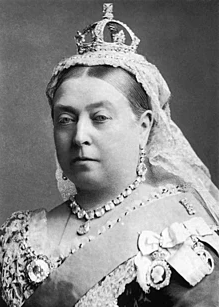 Queen Victoria — Photograph by Alexander Bassano, 1882
Queen Victoria — Photograph by Alexander Bassano, 1882The Victorian-era in the United Kingdom describes the period from 1837 to 1901 when Queen Victoria was on the throne. It was a time of rapid change and saw the country evolve from a largely rural environment to an urban, industrialised one. Almost every aspect of life changed over the course of these sixty years including politics, attitudes to women, health, science and manufacturing.Women were treated little better than slaves
Prior to 1882, once a woman married, in the eyes of the law she ceased to exist. On her wedding day, she became one person with her husband and thereafter everything she did was under his direction.As soon as they married, her property and any money she owned transferred to her husband. Children were also his property. In the event of divorce, prior to 1839, the man could expect custody of his children.The situation improved gradually over the century although undoubtedly women lived in a world that discriminated heavily against them.An act of parliament in 1870 finally allowed women to keep any earnings or property they acquired after they married. By 1873, if a woman divorced, she could retain custody of any children up to the age of sixteen and by 1882 they were finally allowed to retain what they owned at the time of marriage.Despite these victories, men considered themselves the dominant sex. Due to their superior physical strength, they sought to keep women subdued for as long as they could.Medicine and the era of miracle cures
The medicine we take for granted in the 21st century could not have been imagined in the Victorian-era; such was the infancy of medical science.New medicines were seen as miracle cures for a whole variety of ailments included things such as opiates (morphine and codeine) and cocaine. Such were their benefits they were used widely to treat everything from toothache and coughs to diarrhoea and insomnia. The negative effects of prolonged use were initially unknown. It wasn’t until the 20th century that their use became controlled.For some, it was a time of plenty
The industrial revolution undoubtedly changed life in the Victorian-era. Technological advances in the development of machines and steam engines lead to an increase in mass production and improved productivity. The building of railways, canals and roads meant that raw materials and goods could be transported more quickly and cheaply than ever before.Living standards were said to have improved due to an increase in wages although, by the end of the 19th century, towns were so overcrowded that many families lived in squalor. Chronic hunger and malnutrition were common for many, a situation that didn’t improve until the end of the century.For more information on Victorian-era England, visit my website HERE!
Val McBeath
 Val is a scientist by training and has worked in the pharmaceutical industry for many years. Born and raised in Liverpool she now lives in Cheshire with her husband, youngest daughter and cat. In addition to Family History, her interests include rock music and Liverpool Football ClubThe books in the Ambition & DestinySeries are available as ebooks on Amazonand are FREE to read with Kindle Unlimited.
Val is a scientist by training and has worked in the pharmaceutical industry for many years. Born and raised in Liverpool she now lives in Cheshire with her husband, youngest daughter and cat. In addition to Family History, her interests include rock music and Liverpool Football ClubThe books in the Ambition & DestinySeries are available as ebooks on Amazonand are FREE to read with Kindle Unlimited.The paperback books are available from a variety of retailers including Amazon, Barnes & Nobleand Waterstones.
In addition to the outlets above, the short story prequel, Condemned by Fate, is available as a FREE download from www.vlmcbeath.com
Published on September 10, 2019 19:00
September 9, 2019
Join Historical Fiction author, Tim walker, as he takes a look at the Fall of Empires #History #RomanEmpire @timwalker1666
On the Fall of EmpiresBy Tim WalkerI recently watched, in drooling fascination, a one-hour TV documentary on the fall of the Roman Empire, expertly presented by the engaging and idiosyncratic Mary Beard. Striding through the ruins of the monuments of Rome in her designer trainers, Beard cherry-picks what she sees as the main causes of the decline and fall of the mighty Empire of Rome, imaginatively summarising in spoon-sized chunks fit for a TV audience, weighty and complex theories that took Edward Gibbon six volumes to cover in his epic work, ‘The History of the Decline and Fall of the Roman Empire’.

She starts with a saunter along Hadrian’s Wall – the Roman Empire’s most northerly border. Here, she suggests that once Rome had ceased its expansion phase and clearly defined its borders with walls and forts to settle into a period of containment, they became a sitting target for both internal dissenters and external elements - those excluded from the benefits of the empire, who began to ferment opposition. This is an intriguing concept – that once a physical barrier is erected it causes affront to those outside, and can be seen as confinement by some of those within. Witness Donald Trump’s Wall and how it has become a magnet for both desperate migrants on the outside and dissenters within. There is something deeply divisive about physical barriers, and human nature is such that people want to breach barriers placed before them.
Beard does tell us that the decline and eventual fall of Rome took place over three or four generations, and that Rome was sacked on three separate occasions. The first of these was in 410 AD when Alaric, King of the Visigoths, swept into Rome and declared himself King of Rome. This is the same year that the Emperor Honorius wrote to the civic leaders of Britannia to ‘look to your own defences’, signalling the official end of the Roman occupation of Britain. Beard, sitting in a Roman restaurant, cuts her pizza into four quarters and places a cherry tomato in the centre to represent Rome. Then an olive in the centre of each of the four segments. By the time Alaric sacked Rome, it was merely a symbolic centre of a crumbling empire, as administrative power had been devolved to regional territories, where a number of competing emperors jealously guarded their segments. “What set out to be devolution, ended up as disintegration,” Beard ominously intones over the remains of her pizza.
She touches on the decadence, paranoia and isolation of a succession of weak emperors as a contributing factor, giving the example of one emperor who literally drowned his dinner guests in a shower of rose petals. A sweet-smelling way to go. Citizens increasingly felt they were too heavily taxed and resented the impersonality and decadence of imperial authority.
However, the greatest threat to centralised Roman authority came from competing religious beliefs that were allowed to proliferate in the outlying provinces under Rome’s relaxed polytheism -the toleration of a wide range of beliefs. The worship of multiple gods may have been at the heart of the Roman belief system, but this was a part of core shared values, held together by the practice of making sacrifices to the gods for favourable outcomes, and ultimately a belief in the Emperor as a divine or semi-divine figure at the top of the social hierarchy.
Religious devotion in the Roman world was a personal thing – the act of making a sacrifice of animals or crops to a relevant deity at temples or roadside shrines in the hope a favourable outcome to a situation or enterprise. New religions or cults practiced in groups led by a priest, such as with Judaism and Mithraism, were a departure from this, but were felt to be manageable by the Roman authorities as they were, initially, contained in geographical areas. However, when the Romans destroyed the Jewish Temple in Jerusalem, in an attempt to enforce their will, it led to a six-year civil war that ended with a mass suicide of Jewish religious zealots. An even greater threat to the empire’s core values and beliefs was to grow out of Judaism’s spin-off religion – Christianity.
Christianity slowly spread though the empire in the first two centuries AD, with believers no doubt combining elements of pagan belief and ritual with their new faith. However, conflict with the Roman authorities grew when some Christians refused to make sacrifice to the gods, citing their belief in the One True God. Out of frustration, one emperor decided to make it a law that all citizens must sacrifices to the gods, and those refusing to do so were punished. What followed was the persecution of Christians and the infamous ‘Christians versus Lions’ blood sports in arenas across the empire. Beard makes the point that this started to pall when spectators became aware that those being torn to pieces for their entertainment were no longer just slaves, convicted criminals and gladiators, but their own neighbours who had embraced the new religion.
Finally, towards the end of the third century, the Emperor Constantine put an end to this persecution by adopting Christianity as the religion of the vast Roman Empire, elevating a once illegal cult to the law of the land. But at the heart of Christianity was a new ideology that challenged the core beliefs of Roman civilisation, ultimately weakening Rome’s influence over its citizens as it spread across the empire. Beard concludes: “The real heir of the Roman Empire was Christendom, not an empire of political domination, but an empire of the mind and without limit.” She goes on to say that many empires since have drawn on aspects of the Roman Empire and wrestled with its dilemmas, adding, “We in the West still ponder where our boundaries lie, and what limits should be placed on inclusion. We have inherited the Romans’ ambivalence, forever questioning if the end justify the means, the tears alongside the victory parade.”
There is much food for thought in Mary Beard’s well-presented observations that form a prism through which we can reflect on contemporary trends in our own socio-political landscapes. In my historical series, A Light in the Dark Ages, I am fascinated by the return of Britain to tribal kingdoms in the aftermath of Roman withdrawal in the fifth century, and how native resistance to aggressive settler groups ultimately crumbled and gave way to a new wave of colonisation. In the first book in my series, Abandoned, I pose the question, ‘would the Britons have regarded it as liberation or abandonment following the Roman withdrawal?’ The answer for many would most likely have been, ‘a bit of both’ - there were undoubtably some winners, but many losers, as the cloak of protection and ability to organise was withdrawn. The disintegration of infrastructure was inevitable once it became apparent that no successful replacement imperial-minded system came into effect (although some early kings may have delayed it as they tried to mimic Roman ways). Certainly, the Anglo-Saxon colonists who had not lived under Roman rule, had no use for their structures or ways, choosing to build settlements outside the old town walls.
The Romans defended their Britannia land and sea borders for centuries before abandoning their province in order to defend their eastern and southern boundaries from more determined and numerous invaders. Excluding people and tolerating competing ideologies proved to be contributing factors to the undoing of the greatest empire in European history. Many would say the fall of the Roman Empire (indeed, all empires) was a good thing, but an uncontrolled implosion led to many years of hardship and suffering, with unscrupulous and greedy tribal leaders tearing a wide swathe across once peaceful settlements, destroying all that they did not understand or value. Those of us in Britain, teetering on the brink of a disorderly no-deal exit from the European Union (itself regarded by some as a corrupt and inflexible empire), fed on lies and mis-information by self-serving political leaders, have much to dwell on.
A Light in the Dark Ages SeriesStart your adventure today!

Abandoned
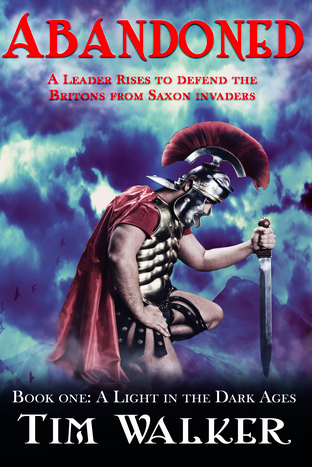
In the year 410 the last Roman Governor of Britannia, Lucius, sailed away from the port of Londinium, never to return. Bishop Guithelin’s desire for a smooth transition in authority to tribal chief Mandubracius leads only to disappointment. Guided by visions from God, Guithelin undertakes a hazardous journey to a neighbouring country to seek assistance from a noble and Christian ruler.
Abandoned is the starting point for an adventure that sets Briton nobles against each other and a foreign prince, whilst keeping one eye on raiders who spill onto the shores and over Hadrian’s Wall. Britannia’s abandonment by Rome presented opportunity for some and anguish and misery for others, as the island slowly adjusted to self-rule.
Through the chaos, heroes emerge, including half-Roman auxiliary commander, Marcus Pendragon, who organises the defence of his town from deadly raiders intent on plunder and murder. Guithelin does his best at diplomacy, never giving up hope for a stable and Godly leader to rule over the tribal chiefs and provide a protective shield for the fearful people of Britannia. But is the preening Prince Constantine the right man?
Marcus fights to protect his family from a range of opportunistic enemies, and by so doing establishes a legacy that will lead to his son, Uther, and grandson, Arthur, becoming kings of Britannia.
Abandoned is book one in a series – A LIGHT IN THE DARK AGES – and is followed by Ambrosius: Last of the Romans and Uther’s Destiny, the latter a winner of the One Stop Fiction Five Star Book Award.
Pick up your copyAmazon
Ambrosius: Last of the Romans
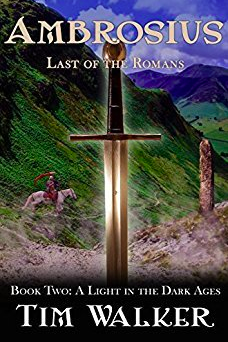
Britannia lies open to barbarian invasions as it slowly adjusts to life after Roman rule. Cruel high king Vortigern has seized control and chosen to employ Saxons in his mercenary army. But who is the master and who the puppet?
Enter Ambrosius Aurelianus, a Roman tribune on a secret mission to Britannia. He is returning to the land where, as a child, he witnessed the murder of his noble father and grew up under the watchful eyes of an adoptive family in the town of Calleva Atrebatum. He is thrown into the politics of the time, as tribal chiefs eye each other with suspicion whilst kept at heel by the high king.
Ambrosius finds that the influence of Rome is fast becoming a distant memory, as Britannia reverts to its Celtic tribal roots. He joins forces with his adoptive brother, Uther Pendragon, and they are guided by their shrewd father, Marcus, as he senses his destiny is to lead the Britons to a more secure future.
Ambrosius: Last of the Romans is an historical fiction novel set in the early Dark Ages, a time of myths and legends that builds to the greatest legend of all – King Arthur and his knights.
Pick up your copyAmazon
Uther’s Destiny
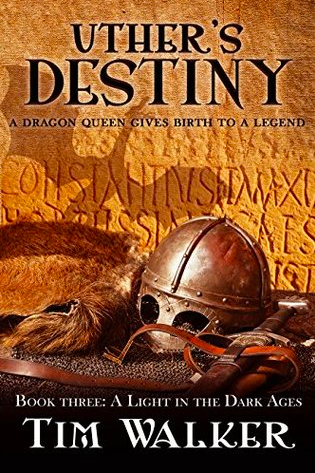
Late fifth century Britannia recoils in shock at the murder of charismatic High King, Ambrosius Aurelianus, and looks to his brother and successor, Uther, to continue his work in leading the resistance to barbarian invaders. Uther’s destiny as a warrior king seems set until his world is turned on its head when his burning desire to possess the beautiful Ygerne leads to conflict. Could the fate of his kingdom hang in the balance as a consequence?
Court healer and schemer, Merlyn, sees an opportunity in Uther’s lustful obsession to fulfil the prophetic visions that guide him. He is encouraged on his mission by druids who align their desire for a return to ancient ways with his urge to protect the one destined to save the Britons from invaders and lead them to a time of peace and prosperity. Merlyn must use his wisdom and guile to thwart the machinations of an enemy intent on foiling his plans.
Meanwhile, Saxon chiefs Octa and Ælla have their own plans for seizing the island of Britannia and forging a new colony of Germanic tribes. Can Uther rise above his family problems and raise an army to oppose them?
Book three in A Light in the Dark Ages series, Uther’s Destiny is an historical fiction novel set in the Fifth Century - a time of myths and legends that builds to the greatest legend of all – King Arthur and his knights.
Pick up your copyAmazon
Arthur Dux Bellorum

From the ruins of post-Roman Britain, a warrior arises to unite a troubled land.
Britain in the late Fifth Century is a troubled place – riven with tribal infighting and beset by invaders in search of plunder and settlement. King Uther is dead, and his daughter, Morgana, seizes the crown for her infant son, Mordred. Merlyn’s attempt to present Arthur as the true son and heir of Uther is scorned, and the bewildered teenager finds himself in prison. Here our story begins…
Arthur finds friends in unexpected quarters and together they flee. Travelling through a fractured landscape of tribal conflict and suspicion, they attempt to stay one step ahead of their pursuers, whilst keeping a wary eye on Saxon invaders menacing the shoreline. Arthur’s reputation as a fearsome warrior grows as he learns the harsh lessons needed to survive and acquire the skills of a dux bellorum, a lord of war.
Tim Walker’s Arthur Dux Bellorum is a fresh look at the Arthurian legend, combining myth, history and gripping battle scenes. Although in a series, it can be read as a standalone novel.
Pick up your copyAmazon
Tim Walker
 Tim Walker is an independent author living in Datchet, East Berkshire. He grew up in Liverpool where he began his working life as a trainee reporter on a local newspaper, The Woolton Mercury. A media career ensued, including a stint overseas in Zambia.
Tim Walker is an independent author living in Datchet, East Berkshire. He grew up in Liverpool where he began his working life as a trainee reporter on a local newspaper, The Woolton Mercury. A media career ensued, including a stint overseas in Zambia.His creative writing journey began in earnest in 2013, as a therapeutic activity whilst recovering from cancer treatment. He began writing an historical fiction series, A Light in the Dark Ages, in 2015, following a visit to the near-by site of a former Roman town. The first book in this series, Abandoned, starts in the year 410 AD, the date given for the end of the Roman occupation of Britain. The aim of the series is to connect the end of Roman Britain to elements of the Arthurian legend, through researched history, presenting an imagined history of Britain in the early Dark Ages.
His latest book is Arthur, Dux Bellorum, a re-imagining of the story of King Arthur, published in March 2019. Book four in the A Light in the Dark Agesseries, it won two book awards in April 2019 - One Stop Fiction Book of the Month and the Coffee Pot Book Club Book Award. He plans to write a second Arthur book for 2020 publication. Abandoned (second edition 2018), is followed by Ambrosius: Last of the Romans (2017), and book three, Uther's Destiny (2018). Series book covers are designed by Canadian graphic artist, Cathy Walker. Tim is self-published under his brand name, timwalkerwrites.
Tim has also written two books of short stories, Thames Valley Tales (2015), and Postcards from London (2017); a dystopian thriller, Devil Gate Dawn (2016); and two children's books, co-authored with his daughter, Cathy - The Adventures of Charly Holmes (2017) and Charly & The Superheroes (2018) with a third in the pipeline – Charly in Space.
Connect with Tim: Website • Facebook • Twitter • Amazon Author Page.
Published on September 09, 2019 20:00
September 8, 2019
Join author, Virginia Crow, as she takes a look at The Loch Ness… Monster? There is also a chance to check out Virginia's fabulous new series — Caledon #NewRelease @DaysDyingGlory
The Loch Ness… Monster?
By Virginia Crow

I am delighted to be back writing for you all and share a little bit about the fascinating stories with have inspired my serial, Caledon. So, before I begin on the journey of my blog, I would like to say a great big thank you to Mary Anne for inviting me to guest post on her fantastic blog.I couldn’t resist the chance to blog about one of the most recognisable creatures of legend anywhere in the world. It has its own road signs and brings in thousands of tourists every year, despite the fact any form of proof in its existence is tenuous at best. Even reported accounts from eyewitnesses can’t agree on very much about it. I’m talking about the Loch Ness Monster or, as it has become more commonly known, Nessie.Much of Scottish culture has come out of the water. It’s not just the thousands of miles of coastline, the entire landscape of peppered with hundreds of lochs and lochans. Amongst these is the enormous Loch Ness which, according to Scottish Natural Heritage, contains more water than every single lake in England and Wales combined. Driving along it you might find it hard to believe, it’s long and thin but nowhere near as wide as Loch Lomond, but Loch Ness is also deep, spectacularly so. It also has an annoying habit of throwing back complicated results on scientific instruments. So, it’s not too surprising with these two factors, that Loch Ness is thought to hold something immense.

It’s first attribution was given in the account of Abbot Eunan (Adomnán) of Iona. This manuscript dates from the late seventh century and recalls St Columba ordering the beast to stop harassing his followers and the Picts, at which point it came to a halt as though it was being pulled back. Whatever miracle Columba administered, it worked for a thousand years. Little by little, however, stories of the monster in Loch Ness began to resurface during the nineteenth century and, by the time of the anonymous “Surgeon’s Photograph” in 1934, a significant percent of the population were willing to accept the Loch Ness Monster existed.Over the past 85 years, “Nessie” has inspired tens of books, several films, a handful of poems, and thousands of edited photographs. The monster, which at times has been referred to as both male and female, encapsulates the perception of Highland landscape, and it’s impossible to walk through Inverness without seeing a hint at its existence.I’ve rummaged through webpages and books finding out all I can about the tales of sighting of this creature, which had me both fascinated and sceptical at the same time. One of the things which struck me the most, however, was how the creature – or one very like it – could be found all around Scotland. They are often bulky creatures with enormous bodies and strong flippers which both churn water and, on very rare occasions, drag them ashore. They always have long necks, a peculiar but unifying feature. Some have the ability to cure cattle; others are menaces which eat food supplies and even people. One of my favourite accounts of one such creature comes from Rev. McLean (quoted in the John O’Groat Journal on Friday 13th March 1840):“When within a few yards of it. finding the water shallow, it raised its monstrous head above water, and by a winding course, got, with apparent difficulty, clear of the creek where our boat lay, and where the monster seemed in danger of being embayed. It continued to move off with its head above water, and with the wind for about half a mile, before we lost sight of it.”But with Columba directing it, and it behaving in different ways towards different people, it begs the question: why? Determined to answer this (after all, that’s what Historical Fantasy is all about!) I turned all Loch Monsters into the same creature. Rather than being trapped in one loch, The Thunderer is bound to one person and – given that many sightings of several of these creatures occurred within a matter of years – it’s an easy thing to imagine that the creature followed an individual.I don’t think I’m alone in this interest. From as far back as St Columba, man has been obsessed by creatures which rise from the deep, where humans still have not conquered. One thing is for sure: with over 750 feet depth of water, it’s very possible something is down there.
Caledon
By Virginia Crow

"Go out and tell all those you meet, Caledon has risen. Caledon will be protected and defended. And to you who would cause her harm, be prepared. A new fight has come."
After the destruction of the Jacobite forces at Culloden, Scotland is divided, vulnerable and leaderless, with survivors from both sides seeking to make sense of the battles they have fought against their fellow Scots.
James Og flees Drumossie, seeking the protection of his uncle's house in Sutherland. It is here that James learns that the Northern Highlands hold a secret power only he can wield: Caledon. When Ensign John Mackay begins hunting Og's family, James realises he must harness this power to defeat the enemies of Scotland.
But, as the ageless Caledon awakes, so too does an ancient evil. When it allies with Mackay, the small Clan of Caledon faces enemies at every turn, discovering that even those closest to them may seek to destroy them.
Part One: Caledon is Called
The first instalment of an Historical Fantasy set in Scotland 1746.
Post-Culloden, Caledon needs a protector. But Her champions are coming from unlikely corners. It soon becomes evident that more than politics are threatening the power of Caledon. An ancient evil rises, determined to conquer the vanquishing power of Caledon once and for all.
This adventure is in eight parts, released fortnightly.
You can read Part 1HERE!!
Virginia Crow
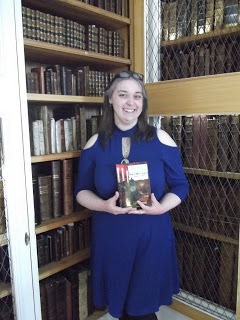 Virginia grew up in Orkney, using the breath-taking scenery to fuel her imagination and the writing fire within her. Her favourite genres to write are fantasy and historical fiction, sometimes mixing the two together such as her soon-to-be-serialised books "Caledon". She enjoys swashbuckling stories such as the Three Musketeers by Alexandre Dumas and is still waiting for a screen adaption that lives up to the book!
Virginia grew up in Orkney, using the breath-taking scenery to fuel her imagination and the writing fire within her. Her favourite genres to write are fantasy and historical fiction, sometimes mixing the two together such as her soon-to-be-serialised books "Caledon". She enjoys swashbuckling stories such as the Three Musketeers by Alexandre Dumas and is still waiting for a screen adaption that lives up to the book!When she's not writing, Virginia is a music teacher in Caithness. She believes wholeheartedly in the power of music, especially as a tool of inspiration. She also helps out with the John o' Groats Book Festival which has just celebrated its 2nd year. Hopefully they'll be plenty more to come!
She now lives in the far-flung corner of Scotland, soaking in inspiration from the rugged cliffs and miles of sandy beaches.
She loves cheese, music and films, but hates mushrooms.
Connect with Virginia: Facebook • Twitter.
Published on September 08, 2019 20:30
September 5, 2019
Has your book got what it takes...? Readers’ Favorite Annual Book Award Contest

Readers’ Favorite
Annual Book Award Contest.
Contest Deadline April 1, 2020
Become an Award Winning Author!

Contest Features
* Chance to win one of $50,000 in free prizes just for entering.
* Chance to have your book made into a movie or TV show. *Chance to be published by an award winning traditional publisher.
*Chance to be represented by a leading author marketing and PR firm. *Chance to be represented by a leading literary management company.*Additional award competition for illustrated books.
* More features including a book review, award ceremony, and publicity.
Readers' Favorite Book Award Contest - Enter Here!
Recommended by

Published on September 05, 2019 20:00
Folklore and Arthurian Legend by Mary Anne Yarde #Arthurian #Folklore #KingArthur
Folklore and Arthurian Legend
By Mary Anne Yarde
In 1846 William John Thoms, a British writer, penned a letter to The Athenaeum, a British Magazine. In this letter, he talked about “popular antiquities.” But instead of calling it by its common name, he used a new term — folklore.
What did Thoms mean by this new word?
The word folk referred to the rural poor who were for the most part illiterate. Lore means instruction. So folklore means to instruct the poor. But we understand it as verbal storytelling.
If folklore is just storytelling, is there any truth in the story of King Arthur and his Knights?
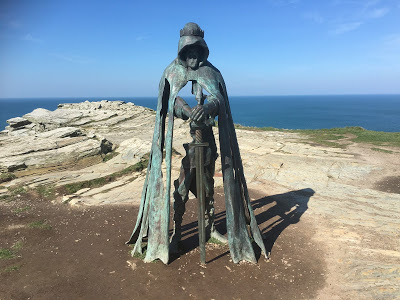 King Arthur statue at Tintagel Castle by Rubin Eynon.
King Arthur statue at Tintagel Castle by Rubin Eynon.Today, I am going to take a look at one of the great Arthurian Writers. I will also try to answer the question I just posed.
"Wave after wave, each mightier than the last,Till last, a ninth one, gathering half the deepAnd full of voices, slowly rose and plungedRoaring, and all the wave was in a flame:And down the wave and in the flame was borneA naked babe, and rode to Merlin’s feet,Who stoopt and caught the babe, and cried "The King!Here is an heir for Uther!"
The above quote was taken from Tennyson’s Idylls of the King and the place Tennyson was referring to was none other than Merlin’s Cave in Cornwall. The cave itself sits under Tintagel Castle, and if you have the slightest interest in Arthur, then I am sure you have heard of Tintagel. If you ever get the chance to visit Tintagel, then do. It is a stunning location, well worth checking out.
 Merlin’s Cave, Tintagel Castle.
Merlin’s Cave, Tintagel Castle.Who was Lord Tennyson?
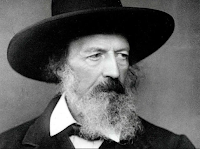 Lord Tennyson.
Lord Tennyson.Alfred Tennyson, 1st Baron Tennyson, (6 August 1809 – 6 October 1892) was the Poet Laureate of Great Britain and Ireland during much of Queen Victoria’s reign. Lord Tennyson was appointed to the position of Poet Laureate in 1850, after the death of William Wordsworth, and he is mostly remembered for his great work — The Charge of the Light Brigade. But I am interested in him because he also published an Arthurian inspired epic poem between 1859 and 1885 and he called it, as I have already said, The Idylls of King.
Now anyone who writes about Arthur, myself included, draws on the work of the Great Arthurian Poets, and Tennyson was no different. But his poem was so epic that he split it into 12 parts, and each part dealt with a different aspect of the Arthurian tale — however, he gave his stories a slight Victorian twist!
Tintagel Castle and Merlin’s Cave.
 Door, Tintagel Castle.
Door, Tintagel Castle.Geoffrey of Monmouth had already given us Tintagel Castle as the birthplace of Arthur. Tennyson took this one step further, and I can understand why he did. There is a cave under Tintagel Castle, and this cave was begging to be included in the tale. The cave in question fills up with water at every high tide, and it is easy enough to imagine Merlin approaching the cave with a shining staff in his hand, lighting his way. If Merlin were to have a cave, then this would be it. This unknown cave became a tourist attraction that suddenly had a long association with Arthurian legend — it was just that no one knew about it until Tennyson told us!
 Inside Merlin's Cave.
Inside Merlin's Cave.Another Arthurian location...
I don’t know about you, but I love checking out film locations. I am lucky enough that I live very near some Poldark film locations. I have also travelled around Scotland checking out the Outlander film locations. Now I am sure you would not disagree with me when I say that neither Poldark or Outlander scream folklore. But when we put the same principles into Arthur’s story then there are some startling similarities because, let’s be honest, if you are going to visit an Arthurian location, it isn’t the same as spending the day at, I don’t know, Hampton Court. You are instead visiting book locations, folklore locations.
 The view from Tintagel Castle.
The view from Tintagel Castle.However, saying that, visiting Arthurian book locations doesn’t feel the same, as visiting the locations of Poldark, Outlander or even Game of Thrones for that matter, because we recognise them as stories, but when it comes to Arthur, we don’t do that. The folklore is so engrained into our culture that we just kind of accept it as maybe not fact, but something very close. And the reason for this is simply because Geoffrey of Monmouth’s great work in the 12th Century was a must read. A factual, must read. And that is where the problem lies with Arthurian folklore. For centuries we were told these stories were true and somewhere ingrained deep down inside us is the belief that they are. Of course, over the centuries there are plenty of people who have exploited the Arthurian story — the monks of Glastonbury Abbey being one of them. But just think on this, a thousand years ago the people of Britain were making pilgrimages — we would probably call it a holiday, or a day out — to these sites that were associated with Arthur and we are still doing it, after all this time. Isn’t that incredible? Arthur is still drawing in the crowds, and I believe that he will continue to draw in the crowds long after we have forgotten all about Poldark and Outlander and even, dare I say it, Jon Snow. And that, my friends, is the power of folklore. It is not the same as a book, it isn’t the same as factual history. It evolves, and we accept it. Suddenly Tennyson’s version of events seems as old as time. Merlin always had a cave...didn’t he? It is humbling when you think about it.
Mary Anne Yarde
 Mary Anne Yarde is the multi award-winning author of the International Bestselling Series — The Du Lac Chronicles. Set a generation after the fall of King Arthur, The Du Lac Chronicles takes you on a journey through Dark Age Britain and Brittany, where you will meet new friends and terrifying foes. Based on legends and historical fact, The Du Lac Chronicles is a series not to be missed.
Mary Anne Yarde is the multi award-winning author of the International Bestselling Series — The Du Lac Chronicles. Set a generation after the fall of King Arthur, The Du Lac Chronicles takes you on a journey through Dark Age Britain and Brittany, where you will meet new friends and terrifying foes. Based on legends and historical fact, The Du Lac Chronicles is a series not to be missed.Mary Anne is the founder of The Coffee Pot Book Club. She has been a professional reader since 2016 and in this time Mary Anne has reviewed many books for the big and small publishing houses, as well as books penned by her fellow indie authors. Mary Anne is also an editorial reviewer for The Coffee Pot Book Club. Mary Anne has been a judge for a prestigious Historical Fiction Book Award for the last three years, as well as being a Top Reviewer on Netgalley.
Born in Bath, England, Mary Anne Yarde grew up in the southwest of England, surrounded and influenced by centuries of history and mythology. Glastonbury — the fabled Isle of Avalon — was a mere fifteen-minute drive from her home, and tales of King Arthur and his knights were part of her childhood.

Published on September 05, 2019 19:00
September 4, 2019
Join Historical Fiction author, Sharon Bradshaw, as she takes a look at Monks, Druids, and The Dark Ages #History #DarkAges #Giveaway @sharonbradshaw0
Monks, Druids, and The Dark AgesBy Sharon Bradshaw

Durstan came to mind when I attended Swanwick, the UK writers’ summer school, in 2009. He was waiting for the arrival of the Vikings who raided Iona during 794AD. It was my debut novel, and I wanted to write a love story about a Monk who broke his vow of chastity at Beltane. When I began to research the Early Medieval period (500-1000AD), I discovered that I had chosen a strangely complex time in history. The more books and archaeology papers I read, the more fascinated I became. I followed the threads back from the 8th century to the late Iron Age, Celts, and Druids. To find out more about the world in which Durstan lived. ...The research I did inspired me to write, The Monk Who Cast A Spell, and the other books in the series.
The British Isles in Durstan’s lifetime were split into tracts of land ruled by Warlords, Kings, and Abbots. Wild animals, the lawless, and those who had been outcast lived in the forest between their enclosures. It must have been a terrifying experience to see a Viking longship on the horizon as the Monks did, but I can’t help wondering whether the Norsemen’s actions were any worse than those of the indigenous Warlords. Many of whom also raided their neighbours’ enclosures, enslaved them, and committed murder. The importance of believing in the most powerful God or Gods soon became apparent. It provided hope of survival in a violent society which in many ways resembled J.R.R.Tolkien’s Middle-Earth. The Ancestors knew that a strong deity could protect them, if honoured properly.
The early Christian Church had arrived in the British Isles several centuries before Durstan’s story begins, but some had still not converted to Christianity or chosen to abandon the Old Gods. People continued to believe in the existence of Elves and Faeries, giant Worms, Dragons and Dwarves. Charms and amulets were prevalent. Superstition was rife, and magic, an everyday occurrence. Monks were initially thought to cast spells, by writing on a piece of parchment. Two altars could exist side by side in a Church, to ensure that both Christian and the Ancestors’ Gods were honoured. Warlords swapped and changed their faith at will, since there was much to fear.

Many still believe that all of the Druids were massacred by the Romans in 61AD, during the Boudican revolt. Historians promoted this view, relying on the sparse accounts which mention them. Both Romans and Church regarded the Druids as their enemy. Tacitus didn’t write about that day on Anglesey from personal experience. Caesar similarly speculates in his books, and the Druids didn't leave behind their own version of events for us to learn the truth. It does however seem likely from the research I did that not all of their order was killed by Gaius Paulinus’ soldiers. Those who were left would undoubtedly have been fewer in number, and had to adapt quickly to survive. As the years passed they might not have had the same extensive knowledge or skills as their predecessors, especially once their schools and temples were destroyed. A Druidic presence in Celtic Ireland did continue, possibly too in other places where the Romans didn’t reach, on the edges of the British Isles. Some joined the Church whilst others may have been absorbed into the Roman temples. Druid Bards told their stories on feast days. Beowulf, and the other fragments we have in the 10th century Exeter Book, are examples of this. A Warlord who had yet to convert to Christianity in 794AD would surely have welcomed into his hall, the man or woman who could read the stars better than himself and converse with the Gods. Even more so, if there was a tale or two to be told!

The Church allowed this worship of the traditional Gods, and other pagan practises, to continue until it had a stronger foothold in the British Isles and could oust them. Adomnan Abbot of Iona (628 -724AD) and biographer of St. Columba (521 -597AD) attributes him with many of the qualities of a Druid. Weather magic, miracles, second sight and angelic apparitions which wasn’t unusual. Other saints were also given these “magical” skills. The Benedictine Rule wasn’t strictly followed in monasteries across the British Isles until many years after Durstan’s story takes place. Some of the Monks married initially, even had children. ...All of which enabled Durstan to celebrate Beltane with Ailan, as a fertility ritual.
The Druids today continue to celebrate the ancient solstices at our sacred sites. Stonehenge, Callenish, and Glastonbury. We don’t know if they follow any of the other teachings of their predecessors who lived in the 1st century. Nevertheless storytelling, tradition, and folklore ensure that our earlier beliefs are not completely lost. Even though they may change with the passage of time. Just as we still have our legends of Arthur, the ancient Tuatha De Danann are thought to be the Old Gods and Goddesses, living now in the Hollow Hills of Ireland. They journeyed to Tir Na Nog or the Celtic Otherworld, the land of the forever young where all is abundant and beautiful, when it became no longer possible to worship them openly because of the rise of the early Church.
The research I did into the background to Durstan’s story placed the Dark Ages in a new light, while the earlier history into which I delved shaped the 8th century where he lived. Folk memory of the distant past may well have been as important then as it is now to us. I continue to be fascinated by those who lived in that time... our Ancestors. These are a few of the books which enabled me to write, The Monk Who Cast A Spell:
The Real Middle EarthMagic & Mystery in the Dark Agesby Professor Brian Bates
Listening For The Heartbeat of GodA Celtic Spiritualityby the Revd Dr J. Philip Newell(former Warden of Iona Abbey)
The Philosopher and The Druidsby Professor Philip Freeman
The Druidsby Peter Berresford Ellis(Historian, Novelist, and Bard of the Cornish Gorsedd)
The Monk Who Cast A SpellBy Sharon Bradshaw
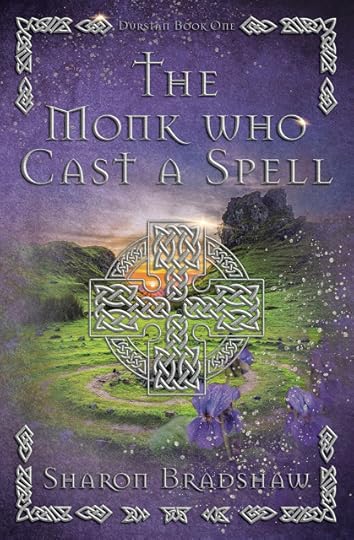
Durstan, a young Monk, falls in love with Ailan in 794AD. She disappears after their sexual awakening at Beltane. He is shocked and confused when he meets her again, several months later. Beth believes that she can obtain the protection of the Christian Church by manipulating Durstan’s emotions, and he is drawn to her.Their love story unfolds against the beautiful scenery of Scotland’s Hebridean islands. People cross the sea in coracles from Iona to Mull. They walk through ancient forest to Lord Duncan’s Hall inside its timber enclosure. The seasons change from Spring to mid-Winter when the Old Gods are in the magic of the firelight, and the shadows at Yule.The early Christian Church continues to be challenged by tradition, and the Druids. Charms, amulets, and spells are prevalent. Life at the monastery is harsh, and Durstan is involved in the Viking raids. He doubts his religious beliefs in a society which is dominated by fear of violence, being outcast, or enslaved. Men and women in the 8th century are seeking protection from the most powerful God; Lord, or Abbot.And Durstan’s quest… to regain Ailan’s love.
Giveaway
Sharon Bradshaw is giving away two eBook copies of her fabulous book
The Monk Who Cast A Spell

All you need to do is answer this question:
If you could talk to one historical person for 5 minutes, who would it be?
Giveaway Rules
• Leave your answer in the comments at the bottom of this post.
• Giveaway ends at 11:59pm BST on September 19th.
You must be 18 or older to enter.
• Giveaway is only open Internationally.
•Only one entry per household.
• All giveaway entrants agree to be honest and not cheat the systems; any suspect of fraud is decided upon by blog/site owner and the sponsor, and entrants may be disqualified at our discretion.
•Winners will be announced in the comments.
• Winner has 48 hours to claim prize or new winner is chosen.
Pick up your copy ofThe Monk Who Cast A SpellAmazon
Sharon Bradshaw
 Sharon Bradshaw is a Historical Fiction Author, Storyteller, and Poet. She loves reading archaeology books, and delving into the 8th century to write the Durstan series. The Monk Who Cast a Spell, available now on Amazon is set in the real Middle Earth we called the Dark Ages. Subscribers to The Storyteller’s Newsletter receive a free short story from her every month.
Sharon Bradshaw is a Historical Fiction Author, Storyteller, and Poet. She loves reading archaeology books, and delving into the 8th century to write the Durstan series. The Monk Who Cast a Spell, available now on Amazon is set in the real Middle Earth we called the Dark Ages. Subscribers to The Storyteller’s Newsletter receive a free short story from her every month. Sharon also enjoys speaking about her novels, and how all this came about. She lives with her family and a large collection of books, near Warwick Castle, in the UK.
Please visit her Website for more information, and follow her on Facebook and Twitter.
Copyright©SharonBradshaw2019
<!-- /* Font Definitions */ @font-face {font-family:"Cambria Math"; panose-1:2 4 5 3 5 4 6 3 2 4; mso-font-charset:0; mso-generic-font-family:roman; mso-font-pitch:variable; mso-font-signature:-536870145 1107305727 0 0 415 0;} /* Style Definitions */ p.MsoNormal, li.MsoNormal, div.MsoNormal {mso-style-unhide:no; mso-style-qformat:yes; mso-style-parent:""; margin:0cm; margin-bottom:.0001pt; line-height:115%; mso-pagination:widow-orphan; font-size:11.0pt; font-family:"Arial",sans-serif; mso-fareast-font-family:Arial; mso-ansi-language:EN;} .MsoChpDefault {mso-style-type:export-only; mso-default-props:yes; font-size:11.0pt; mso-ansi-font-size:11.0pt; mso-bidi-font-size:11.0pt; font-family:"Arial",sans-serif; mso-ascii-font-family:Arial; mso-fareast-font-family:Arial; mso-hansi-font-family:Arial; mso-bidi-font-family:Arial; mso-ansi-language:EN;} .MsoPapDefault {mso-style-type:export-only; line-height:115%;} @page WordSection1 {size:612.0pt 792.0pt; margin:72.0pt 72.0pt 72.0pt 72.0pt; mso-header-margin:36.0pt; mso-footer-margin:36.0pt; mso-page-numbers:1; mso-paper-source:0;} div.WordSection1 {page:WordSection1;} </style> -->
Published on September 04, 2019 20:00
The Coffee Pot Book Club
The Coffee Pot Book Club (formally Myths, Legends, Books, and Coffee Pots) was founded in 2015. Our goal was to create a platform that would help Historical Fiction, Historical Romance and Historical
The Coffee Pot Book Club (formally Myths, Legends, Books, and Coffee Pots) was founded in 2015. Our goal was to create a platform that would help Historical Fiction, Historical Romance and Historical Fantasy authors promote their books and find that sometimes elusive audience. The Coffee Pot Book Club soon became the place for readers to meet new authors (both traditionally published and independently) and discover their fabulous books.
...more
...more
- Mary Anne Yarde's profile
- 159 followers



